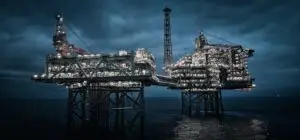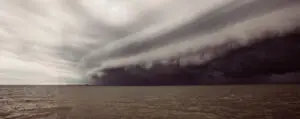Even over 30 years later, the Piper Alpha oil platform disaster has much to teach. The accounts of eyewitnesses and subsequent investigations showed steps that could have prevented the accident and the loss of 167 lives. The explosions that ripped through Piper Alpha injured and traumatized many more people, including the families that lost loved ones on the rig.
We examine what happened on the Piper Alpha oil platform in 1988 and discover the hidden dangers of working on an offshore oil rig.
The Piper Alpha Oil Platform — Describing the Rig
The Piper Alpha oil platform was a fixed platform secured around 120 miles northeast of Aberdeen, Scotland. This was located in the Piper oilfield and sat in about 474 ft. of ocean water. The rig produced natural gas and crude oil, drawing from 36 separate wells. The platform was a hub for multiple pipelines that connected to it from the shore and other nearby platforms.
Several large-diameter pipelines ran to Piper, which then transferred that oil and gas onward for processing and distribution. The platform itself was massive, comprising of many modules and separate structures. Foundation piles fixed it to the seabed on which sat:
- A crane ship
- A drilling derrick
- Multiple utilities
- Living quarters for workers
- Two pedestal cranes
- A helideck
- Flare booms
The Disaster on the Piper Alpha Platform
The incident started when a condensate pump tripped at around 9:45 p.m. on July 6, 1988. This activated the gas alarms, and the first-stage gas compressors were tripped. The flare was noticeably larger than its usual size. At around 10 p.m., a large explosion occurred on Piper Alpha. Survivors testified about hearing a sustained high pitch, described as a screeching noise. This was quickly followed by a large flash and explosion.
Workers in the control room were thrown off their feet and onto the floor. Most of the workers were not on duty and were resting in the accommodation block. Even these men were thrown from chairs or lifted out of their beds.
The initial explosion in the gas compressor module created a chain reaction. It led to a condensate line that connected to a main oil line, which ruptured in an oil separation module. Workers then observed a second bright flash and a massive fireball that launched into the evening sky. At around 10:20 p.m., a separate high-pressure gas line ruptured, releasing an incredible amount of gas. At around 10:50 p.m., another gas line ruptured, releasing gas and causing further explosions.
The Sandhaven, a fast rescue craft, was deployed to help following the initial explosions. However, it was destroyed by the most recent explosion, killing two crewmen onboard and six workers who had just been rescued from the ocean waters. At around 11:20 p.m., the gas line to another platform ruptured. Piper Alpha was now so badly damaged that devastating fires caused the topside to fall apart. The four-story accommodation module, which held 81 workers, slid into the ocean, killing everyone inside.
By early the next morning, most of the top modules were destroyed and had sunk to the bottom of the ocean. Flames from ruptured oil and gas lines reached 200 meters or higher, consuming tons of gas and oil as the conflagration continued. It was over three weeks later before all of the flames were finally extinguished. The last parts of Piper Alpha succumbed to the ocean on March 28, 1989.
The Victims and Survivors
226 people were originally onboard Piper Alpha that evening. Only 61 survived to tell their story. Of the deceased victims:
- 13 perished by drowning
- 109 died of smoke inhalation
- 11 died from their burn injuries
- 4 causes of death could not be determined
- 30 bodies were never recovered
Family members of the deceased suffered the grief of losing their loved ones and the financial hardships associated with that loss. Of those who survived, many suffered severe burns, smoke inhalation damage, and incredible trauma.
What Caused the Piper Alpha Disaster?
Investigators later learned that on that evening, condensate pump A required maintenance on its motor drive coupling. Its pressure relief valve had been set aside for maintenance, all of which occurred through a separate permitting process. A blind flange was likely put in its place despite not being pressure tested or leak tested. When pump B tripped, operators chose to try to restart it because they did not know that the pressure relief valve for pump A was missing.
Investigators believe that condensate leaked from the blind flange on pump A and ignited. This led to a continuing failure down the line as explosions and fires rocked Piper Alpha.
The investigation led to many findings and lessons learned for the oil industry. Rigs faced increased safety practice scrutiny and new regulations. The investigation determined that many issues helped lead to the disaster, such as:
- Design issues on the rig
- Personal safety and process safety issues
- Complacency in safety culture
- Inadequate emergency response and coordination
- Lack of communication between crews
- Improper permitting
The Civil Lawsuit After Piper Alpha
Survivors and the families of the deceased filed lawsuits against several defendants, including Occidental, Piper Alpha’s owner. Survivors sought compensation for their injuries and the emotional trauma they suffered from the incident. Family members sought wrongful death damages such as grief and lost income. After several years of lawsuits and negotiations, Occidental paid over $220 million in settlements to the injured parties.
Lloyd’s of London, Occidental’s insurer, which paid these claims, filed civil lawsuits against several contractor companies it claimed were responsible for the accident. It sought contribution and indemnity from many of these parties, arguing their liability required them to pay for these costs.
The Impact of the Piper Alpha Oil Platform Disaster
This disaster’s impact is still felt to this day. The oil and gas industry forever changed, making vital improvements to worker safety and processes. However, later disasters like the Deepwater Horizon in 2010 demonstrate that serious incidents are still possible and that lives are at risk. Injured workers likely have compensation rights after an offshore oil rig injury.
Sources:









